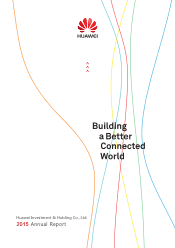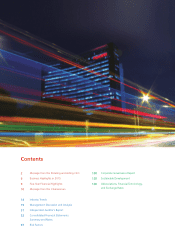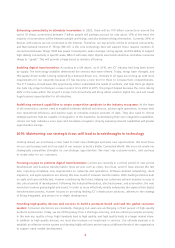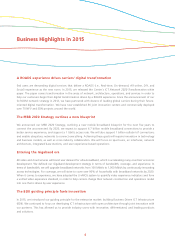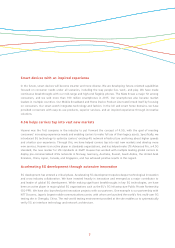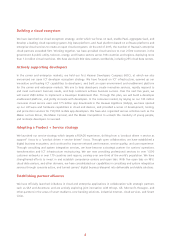Huawei 2015 Annual Report Download - page 4
Download and view the complete annual report
Please find page 4 of the 2015 Huawei annual report below. You can navigate through the pages in the report by either clicking on the pages listed below, or by using the keyword search tool below to find specific information within the annual report.
2
Message from the Rotating and Acting CEO
Ideals are not enough. We also need new
theory. Ideals give us a vision, and theory
gives us the means to achieve it. Over the next
10 to 20 years, we must boldly explore new
technological concepts, mathematical models,
and algorithms, and in doing so provide
society with new theoretical approaches in
these areas. In the future, networks will be
standardized, simplified, and easy to use. We
must broaden our horizons, have a global view,
and work together to create value. We must
build networks on globally unified standards.
And we need to make our contribution to the
concepts, theory, and architecture of future
data transmission.
2015: Focusing on pipe produced remarkable results
In 2015, Huawei's revenue reached CNY395 billion (US$60.8 billion based on the year-end exchange rate), an
increase of 37% year-on-year. Our carrier, enterprise, and consumer businesses all met the sustainable growth
targets set by our Board of Directors at the beginning of 2015. While creating value for our customers, we have
also increased the value of our company. And since the adoption of our pipe strategy, this year in particular has
produced remarkable results.
In our carrier business, our 4G equipment was widely deployed around the world and is now being used in the
capital cities of over 140 countries. We recently launched our 4.5G solution to meet consumer demand for a better
experience while protecting carrier investment in 4G. We have built over 280 commercial networks with our 400G
core routers. Having implemented our Product + Service strategy, we now support the operations of over 1,500
networks globally, serving more than one-third of the world's population in over 170 countries and regions. More
and more carriers now recognize Huawei as a trusted strategic partner.
In our enterprise business, we applied our guiding principle of Business-Driven ICT Infrastructure (BDII) to lead the
transformation of enterprise IT towards cloud architecture, and the transformation of enterprise networks towards
SDN. We remain open to being integrated, and continue innovating jointly with our customers and partners. Globally,
we are setting the pace for IT systems based on cloud architecture. Many Fortune Global 500 companies, such as
the Industrial and Commercial Bank of China, the China Construction Bank, Deutsche Bahn, Mercedes-Benz, and
Volkswagen, have selected Huawei as their partners. We have participated in the construction of over 660 data
centers, including 255 cloud data centers. In the future, we will continue to work with our partners to create a
sustainable ecosystem for the cloud computing industry.

